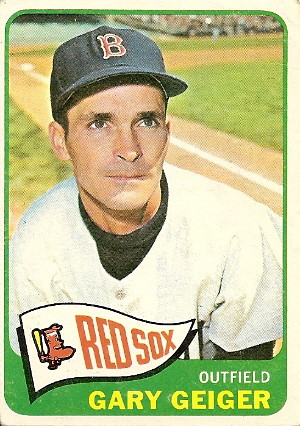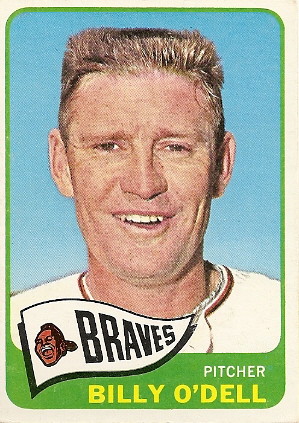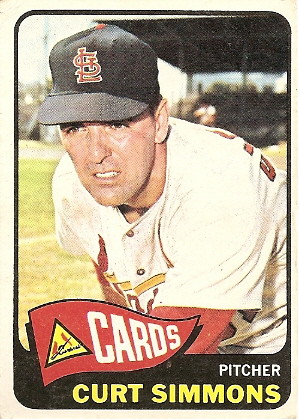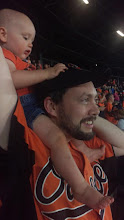I've previously mentioned the excellent book October 1964, and the first two players in today's post are players in that story as well. Curt Simmons had started his career with the Phillies, his breakout season coming during the 1950 "Whiz Kids" campaign (17-8, 3.40 ERA). He had several more strong seasons for the Phils, winning 115 games total for them. But arm injuries cost him most of 1959 and contributed to a poor start in 1960, and Simmons was released on May 17. The Cardinals picked him up three days later, and he quickly returned to form, winning 59 games over the next five seasons. The Cardinals' 1964 World Series win over the Yankees would not have been possible without the three aces at the top of their starting rotation: Bob Gibson (19-12, 3.01), Ray Sadecki (20-11, 3.68), and the 35-year-old Simmons (18-9, 3.43). Of course, the Cardinals won the NL pennant in thrilling fashion, surging from behind to overcome Simmons' former team from Philadelphia. Speaking of which...
Much has been written about the historic collapse of the 1964 Phillies, who blew a six-and-a-half game lead in the season's final twelve games by losing ten straight. If manager Gene Mauch had a little more faith in Art Mahaffey, maybe things would have been different. Mahaffey was about league-average for a starting pitcher for most of his career; even in 1962, when he won a career-high 19 games, his 3.94 ERA was higher than the mean. Still, Art was fairly solid in that 1964 season, winning 12 and losing 9 with a 4.52 ERA. During the Phils' slide, he pitched some good games. He lost the first of the ten, a hard-luck 1-0 game against the Reds. He waited until game six for another turn, leaving in the eighth inning with a thin 4-3 lead over the Braves that was surrendered by the bullpen. Finally, he made one more appearance in relief, tossing a scoreless third inning in the ninth consecutive loss after Dennis Bennett was chased early by the Cardinal bats.
Rather than give Mahaffey his last regularly scheduled start or two, Mauch was running Jim Bunning and Chris Short (his two top starters) to the mound on extremely short rest, with predictably poor results. Art would last for just two seasons beyond 1964, his career finished at age twenty-eight. His manager's lack of confidence may have affected Art, but it was more likely the residual effects of an arm injury in 1963 that had sapped him of his velocity.

Gary Geiger looks somewhat baby-faced for a 27-year-old outfielder. He also might be suppressing a laugh at the expense of that excellent vintage Red Sox logo. So much better than the ho-hum pair of non-anthropomorphic socks they have now. Gary had a rough year in 1964, as he dropped to 135 pounds (from a playing weight of about 170) following an operation for a bleeding ulcer. He played in just five games that year. Other fun (but unfortunate) facts: he wore false teeth from the age of 22 onward (his own teeth were too soft to have the cavities filled, so he had them pulled), and he had a fear of flying. As a player, he was a pretty good pitcher in the minors before switching to the outfield. He hit 70 of his 77 career home runs in his first five years in Boston, but the medical emergency in 1964 marked the end of his days as a regular.

We're going out in style! This is my favorite card yet in my budding 1965 Topps set. Why? Just look at Billy, with his no-nonsense flattop (Flattop #2 in my set, following Hal Woodeshick) that you could set a watch to. His wide, aw-shucks grin illuminates every crag and crease in his weathered face; if Gary Geiger is the youngest 27-year-old around, Billy O'Dell may be the oldest 32-year-old. He looks like he stepped right out of a John Wayne movie.
I also love this card because Billy is one of the earliest of the ex-Orioles. He was signed as a bonus baby in June 1954, joining the team just two months after they debuted in Baltimore. His earned run average was well below league average for each of his three full seasons in orange and black, and he made two All-Star teams in that span. His most memorable moment may have been the 1958 Midsummer Classic, when he shut the door on the NL boys with three perfect innings (including strikeouts of Hall of Famers Ernie Banks and Bill Mazeroski). O'Dell earned the save in front of the hometown fans in Memorial Stadium.




Kevin - a great conclusion to the review of the cards I sent. Thanks for doing such great research on these players, and giving me much greater appreciation for these guys. If I ever end up with extra '65s, they've got your name on them.
ReplyDelete